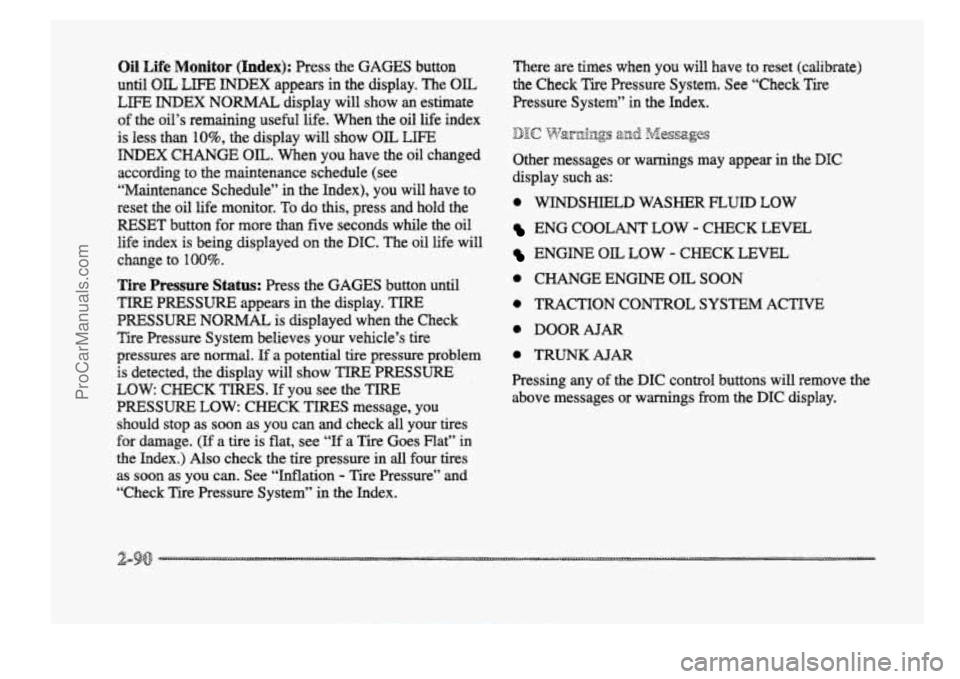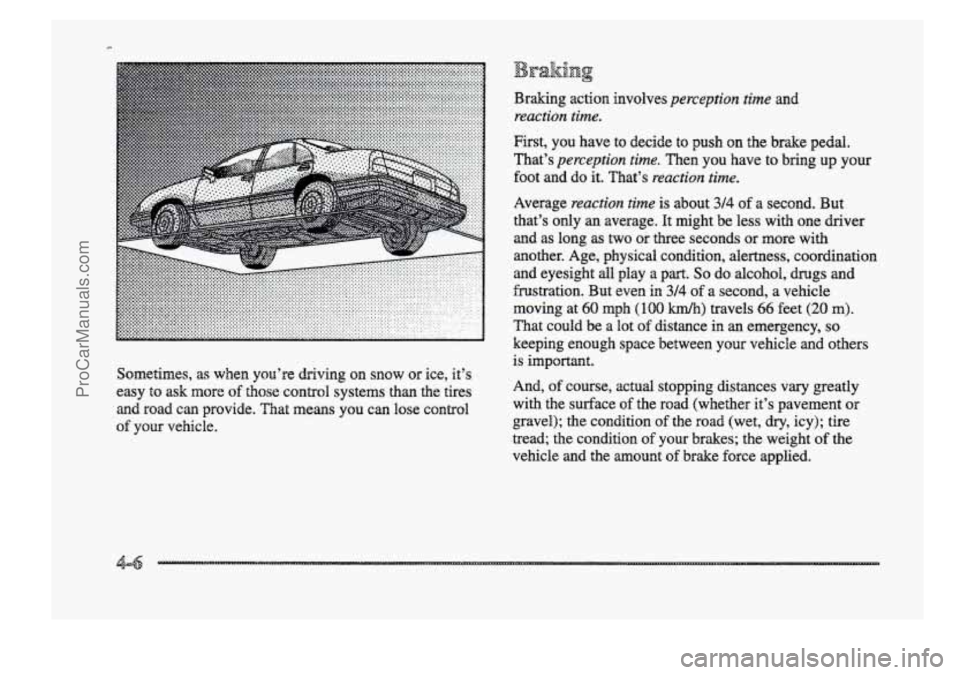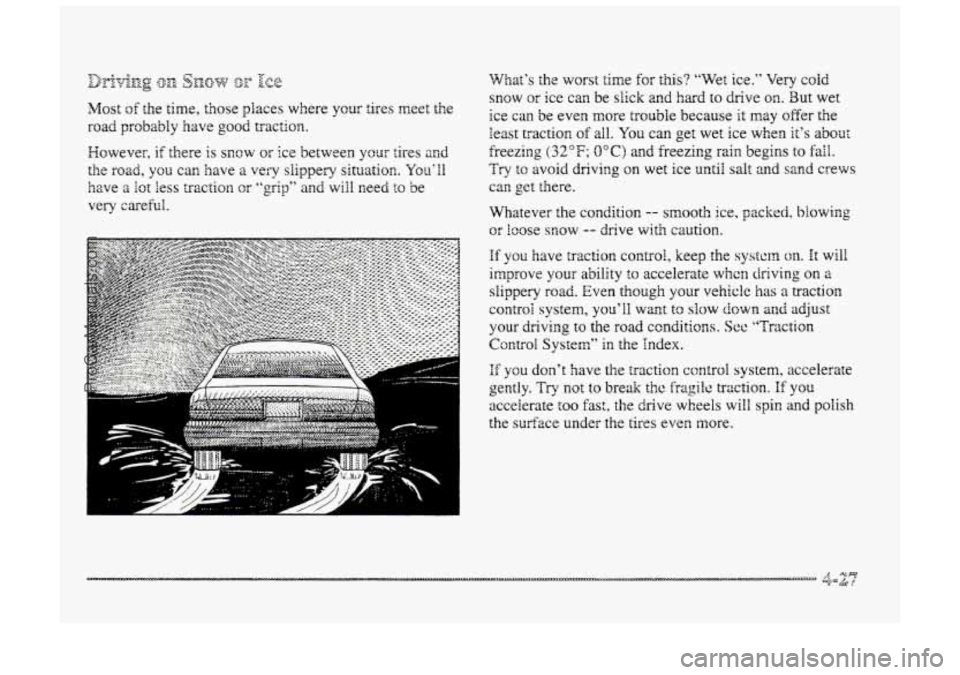Page 156 of 426

Oil Life Monitor (Index): Psess the GAGES button
until OIL LIFE INDEX appears in the display. The OIL
LEE INDEX NORMAL display will show an estimate
of the oil’s remaining useful Me. When the oil life index
is less
than IO%, the display will show OIL LIFE
INDEX CHANGE OIL. When you have the oil changed
according
to the maintenance schedule (see
“Maintenance Schedule” in the Index), you will have to
reset the oil We monitor.
To do this, press and hold the
RESET’
button for more than five seconds while the oil
life index
is being displayed on the DPC. The oil life will
change to
100%.
Tire Psessure Status: Press the GAGES button until
‘FWE IPWSSUWE appears in the display. TWE
PRESSUWE NORMAL is displayed when the Check
Tire Pressure System believes your ve~cle’s tire
pressures are normal. If a potential tire pressure problem
is detected, the display will show gIRE PRESSURE
LOW CHECK TIRES. If you see the azRE
PRESSURE LOW: CHECK TIRES message, you
should
st~p as soon as you can and check all your tires
for damage. (If a tire is flat, see ‘‘If a Tire Goes Flat” in
the Index.)
Also check the tire pressure in all four tires
as
soon as you can. See “Inflation - Tire Pressure” and
“Check Tire Pressure System” in the Index. mere
are
times when you will have to reset (calibrate)
the
Check Tire Pressure System. See “Check Tire
Pressure System” in
the Index.
jJ&m&qgs sj& &ssag@j
Other messages or warnings may appear in the DE
display such as:
0 WINDSHIELD WASHER FLUID LOW
ENG COOLANT LOW - CHECK LEVEL
ENGINE OIL LOW - CHECK LEVEL
0 CHANGE ENGINE OIL SOON
0 TRACTION CONTROL SYSTEM ACTIVE
0 DOOR AJAR
0 TRUNKAJAR
Pressing any of the DIC control buttons will remove the
above messages or warnings
from the DIC display.
ProCarManuals.com
Page 207 of 426
YO:; have three systems that make YQLX vehick go wircre
you want it to go. They are the brakes, the steering anti
the accelerator. AH three systems have to do their work
at the places where the tires meet the road.
ProCarManuals.com
Page 208 of 426

Sometimes, as when you’re driving on snow or ice, it’s
easy
to ask more of hose control systems than the tires
and road can provide.
That means you can lose control
of your vehicle. Braking
action involves perreption
time and
reaction time.
First, you have to decide to push on the brake pedal.
That’s
perception time. Then you have to bring up your
foot and do it. That’s reaction time.
Average reaction time is about 314 of a second. But
that’s
only an average. It might be less with one driver
and as long
as two OS three seconds or more with
another. Age, physical condition, alertness, coordination
and eyesight
dl play a part. So do alcohol, drugs and
frustration. But even
in 3/4 of a second, a vehicle
moving at
60 mpph (100 km/h) travels 66 feet (20 m).
That could be a lot of distance in an emergency, so
keeping enough space between your vehicle and others
is important.
And,
of course, actual stopping distances vary greatly
with the surface
of the road (whether it’s pavement or
gravel); the condition
of the road (wet, dry, icy); tire
tread; the condition
of your brakes; the weight of the
vehicle and the
amount of brake force applied.
ProCarManuals.com
Page 213 of 426
It‘s important to take curves at ;r reasonable speed.
A lot of the “driver lost control” accidents mentioned on
the news happen on curves. Here’s why:
Experienced driver or beginner, each of us is subject to
the same laws of physics when driving on curves. The
traction of the tires agzjinst the roaC surface makes it
possible fcr the vehicle to change its path when you turn
the front wheels. If there’s no traction, inertia wiHl keep
the vehicle going in
the same direction. If you‘ve ever
tried
to steer a vehicle on wet ice, YQK‘IB understacd this.
The
trzctionr YOU can get in a curve depends on the
condition of your tires md the road surface, the angle at
which Gie curve
is banked, and your speed. Mile you’re
in ip curve, speed is the one fxtor you can control.
Suppose ycu’re steering through a sharp curve.
Then you suddenly accelerate. Both control
ProCarManuals.com
Page 221 of 426
Driving too fast through large water puddles or even
going through some car washes can cause problems, too.
The water may affect your brakes. Try to avoid puddles.
But if you can’t, try to slow down before you hit them. Hydroplaning
is dangerous. S:, much water can build up
under
your tires that they cm actually ride on the water.
This can happerm If the road is wet enough and you’re
going fast enough. When your vehicle
is hydroplaning,
it has little or no contact with the road.
Hydroplaning doesn’t happen often. But it can if your
tires do not have much tread or if the pressure in one or
more is low. It can happen if a lot of water is standing on
the road. If you can see reflections from trees, telephone
poles or other vehicles, and raindrops “dimple” the
water’s surface, there could
be hydroplaning.
ProCarManuals.com
Page 226 of 426
]Is there actually such a ~~nrdition as “highway
hypnosis”? Or is it just plain falling asleep at the wheel?
Call it highway hypnosis, lack of awareness,
or whatever.
mere
is something about an easy stretch of road with
the same scenery, dong with the hum of the tires on the
road, the &one
of the engine, and the msh of the wind
against the vehicle
that can make you sleepy. Don’t let it
happen to you! If it does, your vehicle can leave the
road in less than a secondy and you could crash agld
be injured.
@ Keep YQW eyes moving. Scan the road ahead and to
the sides. Check YOLK rearview ~~II-QI-S and your
instruments frequently.
@ If you get sleepy, pull off the road into a rest, service
or parking area and take a nap, get some exercise, or
both. For safety, treat drowsiness on the highway as
an emergency.
ProCarManuals.com
Page 227 of 426

HE you drive regdarly in steep country, or if you're
planning to visit there, here are some tips that can make
your trips safer and more enjoyable.
Keep yoas vehicle in
good shape. Check all fluid
Bevels
and also the brkes, tires, cooling system
and transaxle. These par"cs can work had on
mountain
roads.
8 Know how to go down hills. "he most imp~rtmt
thing to how is this: le: your engine do some of the
slowing ~QWII. Shift to a lower gear whm YOU go
down a steep or long hill.
b
If you ddt shift down, your brakes coddl get so
hot that they wouldn't work wel. YQU would then
have poor braking or even none going down a
hill. You could crash. Shift down to Bet your
engine assist YOW brakes on a steep
downhill slope.
8
a,
Know how to go uphill. Drive in the highest
geX pOSSibke.
Stay in your own lane when driving an two-lane
roads in hills or mountains. Don't swing wide GT cut
across the center of the road. Drive at speeds tha': let
you stay in your own lane.
As yo.^ go over the top of a -hill, be dert. There could be
somettzlng h you- lane, %e a stailed car or m accident.
You may see highway signs on mountains that wanz of
specid problems. Examples ae H~ng grades, passing or
no-passing zones, a falling rocks area or winding
roads. Be alert to these and take appropriate zction.
ProCarManuals.com
Page 229 of 426

However, if there is snow OF ice between yorar tires and
the road, you can have a very slippery situation. You’ll
have a lot less traction cr “grip” and will need to be
very careful.
..........
..-- ... .. ‘ _._ , .....
What’s the worst time for this? “Wet ice.” Very cold
snow or ice can be slick 2nd hard to drive on. 3ut wet
ice can be even more trouble because
it may oEer the
least traction of all. You can get wet ice when it’s about
freezing
(,32”F; OOC) and freezing rain begins to fail.
Try to avoid driving on wet ice until salt 2nd sand crews
can get there.
Whatever the condition
-- smooth ice, packed, blowing
or hose snow -- drive with caution.
If you have traction control, keep the systcrn on. It will
improve your ability
to accelerate when driving on a
slippery road. Even though your vehicle has a traction
controi system,
you’ll want to slow down and adjust
your driving to the road conditions. Sec ‘‘Trrrctionr
Control
System” in the Index.
If you don’t have the traction control system, accelerate
gently.
Try not to break thc FragiEt: Fraction. If you
acceierate too fast, the drive wheels will spin and polish
the surface under the tires even more.
ProCarManuals.com